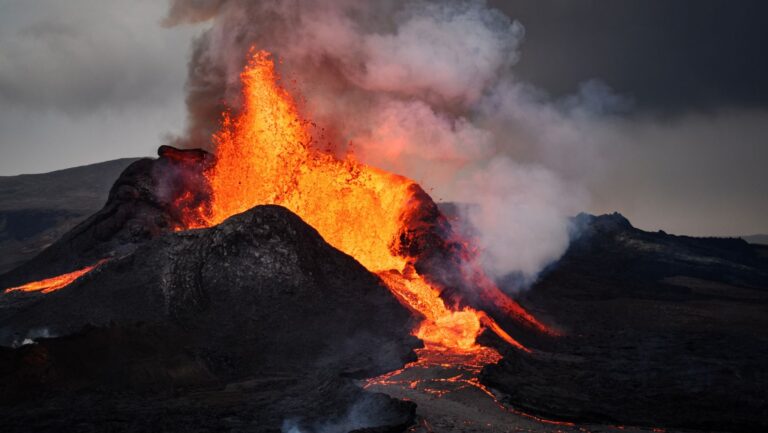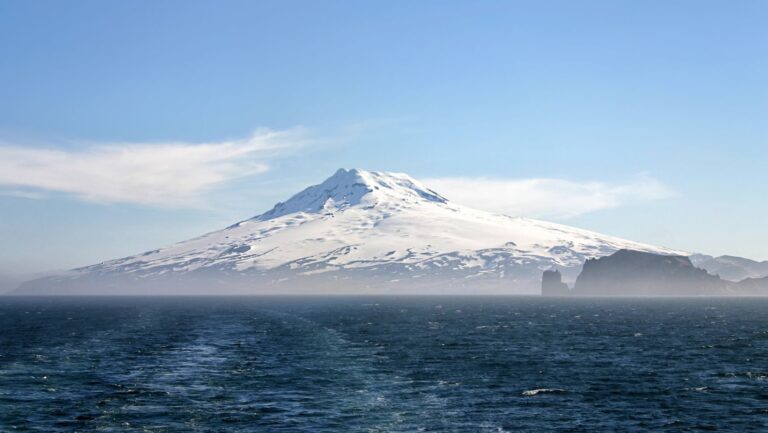Unlike Iceland, residents of Norway don’t have to fear volcanic eruptions that could hit towns and cities. But researchers have found fascinating traces of volcanic activity in the geological history of Norway.
The recent eruption on Iceland’s Reykjanes peninsula has brought the world’s attention to the land of ice and fire once again. Norway too has a fiery past.

Contrary to its current landscape, Oslo was once an inferno, about 300 million years ago. This period was marked by supervolcanoes, which covered large areas with ash and lava, reminiscent of the dramatic landscapes of Iceland today.
Reidar Müller, in his book “Norge. Landet vårt gjennom tre milliarder år” (Norway. Our country over three billion years), explores these ancient volcanic events.
Underwater volcanoes
He narrates the history of the huge desert in Brumunddal, the oldest traces of life in Alta, and even mammoth teeth discoveries in Gudbrandsdalen. Particularly fascinating is his account of underwater volcanism, which is still ongoing in Norwegian waters.
The Mid-Atlantic Ridge, part of which lies within Norwegian territory, witnesses active volcanism and is the site of about one volcanic eruption in Norwegian deep-sea areas every year.
Volcano on Jan Mayen
Norway's only active volcano on land is Beerenberg on Jan Mayen, an island located between Greenland, Iceland, mainland Norway, and Svalbard.
This volcano, almost 2,300 metres high with a diameter of approximately 20 km, was thought to be extinct until a surprise eruption in 1970. It erupted for about three weeks, adding another three square kilometres of land mass to the island. The volcano also erupted in 1973 and 1985.

Another significant area of geological interest is Spitsbergen in Svalbard, known for its hot springs, which are remnants of volcanic activity dating back between 100,000 and 250,000 years ago.
Moreover, the seabed along Norway’s mid-ocean ridge features hydrothermal vents, where water drawn into the Earth's crust dissolves metals and emerges through chimney-like structures, resembling black smoke.
This process has led to discussions about mineral extraction from these sites. Notably, the metals in several Norwegian mines come from such ancient underwater hot springs.
The geological history of Norway also includes the ancient Iapetus Ocean, where volcanism formed metal-rich mineral deposits, such as those extracted at Røros, Folldal, and Løkken. This oceanic activity laid the foundation for many mining communities in Norway.
Volcanic activity in Oslo
The violent volcanic activity that once occurred in Oslo left dramatic traces. Müller describes Oslo as a volcanic inferno with fire-spewing fissures in the Earth's crust, akin to Iceland's current landscape.
The Oslo area experienced volcanic activity for about 70 million years, forming large fissure volcano systems and eventually, supervolcanoes.
The geological forces at play were so intense that Norway was almost split in two, with movement between Vestfold and Østfold. The thinned and cracked Earth's crust formed a rift allowing magma to seep through, which could have transformed the Oslofjord into a sea had the trend continued.
A volcanic past beyond Oslo
Traces of ancient volcanism are not limited to Oslo. The Fen Complex in Telemark, for example, showcases remnants of a volcano active 580 million years ago, containing rare carbonatite lava. This site is significant for its deposits of rare earth metals and thorium.
Despite this fiery past, Müller reassures that there is no risk of volcanic eruptions in mainland Norway today. Minor earthquakes rooted in the old rift may occur in Oslo, but they pose no significant threat.
Norway's volcanic history is a compelling chapter in the Earth's geological narrative. From fiery infernos to silent, deep-sea vents, Norway's landscape tells a story of a dynamic Earth, continually reshaped by the forces of nature.

